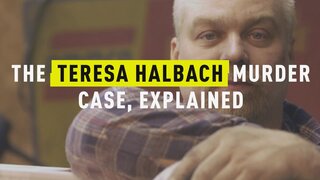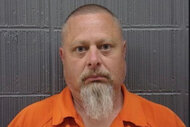Create a free profile to get unlimited access to exclusive videos, breaking news, sweepstakes, and more!
Steve Avery's Lawyers Launch New Effort To Get Another Trial
The legal team representing the "Making a Murderer" subject say prosecutors violated Avery's right to due process by not handing over evidence that could potentially clear him of the murder of Teresa Halbach.

The lawyer representing Steven Avery filed lengthy brief Monday asking the Wisconsin Appeals court to grant her client either a new trial or evidentiary hearing.
Avery’s post conviction lawyer Kathleen Zellner filed the 135-page document with Wisconsin Court of Appeals on Monday regarding his 2007 murder conviction for the death of photographer Teresa Halbach.
“We are thrilled to have Steven’s brief filed and we look forward to the first unbiased, fair and competent review of these issues,” Zellner tweeted on Monday.
Avery and his nephew, Brendan Dassey, were both sentenced to life in prison in 2007 for the murder of Halbach two years earlier. The first season of the Netflix docu-series “Making a Murderer” examined the case and raised the possibility that they were wrongfully convicted, suggesting police mishandled the case, including taking advantage of Dassey's limited intellect in order to induce a confession. The second season focused on Zellner’s efforts to get Avery exonerated. If that were to happen, it would be his second high-profile exoneration –– a 1985 conviction for sexual assault and attempted murder was overturned in 2003.
The newly filed brief presents various arguments, including the allegation that prosecutors withheld vital information that could've changed the outcome of the trial. Zellner claims there were at least six Brady violations –– referring to instances where the prosecution suppresses evidence that is favorable to the accused party.
The six alleged Brady violations are as follows:
- In 2017, a new witness named Kevin Rahmlow came forward claiming that he had not only seen Halbach’s RAV-4 parked at a highway turnaround on both Nov. 3 and 4 of 2005 –– days after Halbach was killed –– but that he called police to let them know. He says he spoke to Sgt. Andrew Colborn specifically. (Colburn threatened to sue Netflix over “Making a Murderer” last year because he felt he was wrongfully depicted as corrupt.)
“Mr. Rahmlow’s observation of the RAV-4 on November 3 and 4, 2005 is material to the defense theory that evidence was planted to frame Mr. Avery,” Zellner writes in her brief. “If the RAV-4 was spotted at the turnaround on Highway 147 on November 3 and 4, 2005, then it must have been moved and planted on the Avery property before it was discovered on November 5, 2005. [...] Mr. Rahmlow’s testimony would have established that Mr. Avery was framed for Ms. Halbach’s murder.”
The brief adds, “if the RAV-4 left the property, the State’s theory that Ms. Halbach’s murder occurred exclusively on the Avery property would be completely debunked.”
- Another witness, Joshua Radandt, who owned a quarry adjacent to the Avery property, claimed that around Nov. 5, he was told around by Department of Justice investigators that they believed Halbach’s RAV-4 was moved through his property onto Avery’s lot –– a belief that was never expressed in any official report on the case.
“Mr. Radandt’s affidavit is similar to Mr. Rahmlow’s affidavit in that it directly contradicts the State’s denial that the RAV-4 was planted,” Zellner’s brief claims.
- The third alleged Brady violation refers to a flyover video of the Avery lot conducted on Nov. 4. Zellner notes that the prosecution claims that the RAV-4 was not seen during the flyover because it was covered with branches. However, she claims that the sheriff’s department “were in the air for around 4 hours yet produced only 3 minutes of flyover footage” and that “the edited version did not show the southeast corner of the salvage yard [where the RAV-4 was found] at all, much less a vehicle covered with branches.”
She says if “video was intentionally edited to delete the footage of the southeast corner, this is a Brady violation because the issue of whether the RAV-4 was planted was material to Mr. Avery’s conviction.”
- Halbach visited another home the day she died, the Zipperer househoud. She left a voicemail on their answering machine when she could not find their residence, and that voicemail was recorded onto a CD by investigators. Zellner claims the CD was never turned over to trial defense counsel and was later lost.
“The contents of the Zipperer voicemail may have contradicted the timeline established by the State that Ms. Halbach’s last stop was the Avery salvage yard,” Zellner writes.
- A phone conversation that Halbach made from her car the day she died allegedly indicated that she had her day planner in the vehicle with her when she visited the Avery property. However, that phone call and the day planner were never part of the evidence. Instead, Halbach’s ex-boyfriend, Ryan Hillegas is believed to have been in possession of the planner post-death. Zellner argues if the phone call was disclosed to trial defense counsel then “it could have been used to directly connect Mr. Hillegas to the crime.”
- A computer in the Dassey house, located on the Avery lot, was allegedly used to search for violent pornography, and included search terms like "bondage," "blood,” "rav," "stab," "throat," and "DNA,” according to the brief. Zellner has previously put forth a theory that Bobby could have killed Halbach. She accused him in the past of lying about what he had been doing the day Halbach visited the Avery lot. He told police he’d been sleeping until around 2:30 p.m. that day and observed Halbach arriving on the property to take pictures of a van around that time. He says the last time he saw her, she was approaching Avery’s house, establishing Avery as the last known person to see her alive. In the brief, however, Zellner claims that the search history on the computer shows someone was using it at numerous points during the day. With Bobby allegedly the only one at home, it would have been impossible for him to have been asleep as he testified, and thus calls his credibility into question, Zellner argues.
In fact, Zellner claims that the state had 1,625 violent pornography images from the Dassey computer that “depicted violent images of the torture and mutilation of young females, many of whom bore a striking resemblance to Ms. Halbach.” She writes that the state destroyed those images and that “suspiciously,” the images were “not accessible to trial defense counsel in the prosecutor’s files.”
Other alleged violations cited in the brief include Zellner’s accusation that the circuit court never addressed Avery’s claim that he had ineffective counsel at trial. Avery's trial attorneys never took the opportunity to cross examine a forensic anthropologist, ballistics expert or Bobby Dassey, according to Zellner. Zellner also claims that her client’s former attorneys also failed to look at any other possible suspects, including Halbach's boyfriend and Bobby Dassey.
Zellner also argues that the circuit court improperly denied a motion about human bones found in the Manitowoc County Gravel Pit, which were given to the Halbach family without informing Avery. She previously filed a motion asking Wisconsin's Appellate Court to remand the case back to a state circuit court in order for bones, believed to be Halbach’s, to be tested for DNA. Zellner said she believed that testing would have proved the bones were planted behind Avery's trailer, thus exonerating him.
The Wisconsin Department of Justice has until Nov. 13 to respond to Zellner's brief.
Dassey, meanwhile, is taking his own steps in his attempt to be released from prison. He has recently filed for clemency.






















